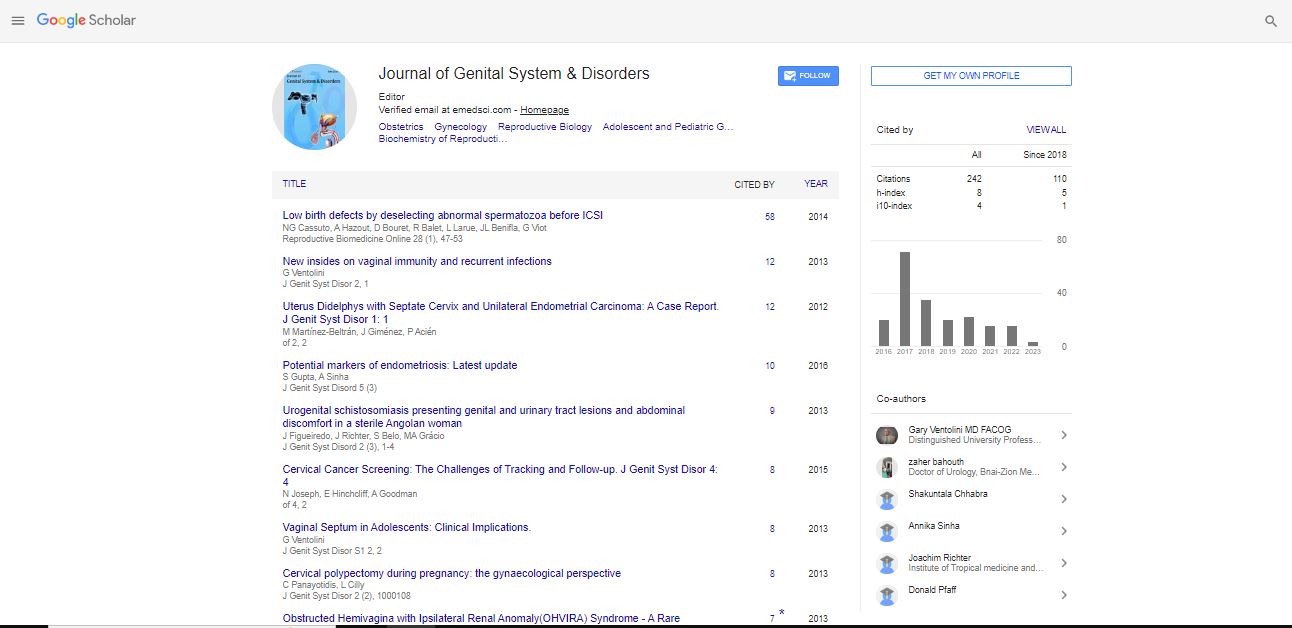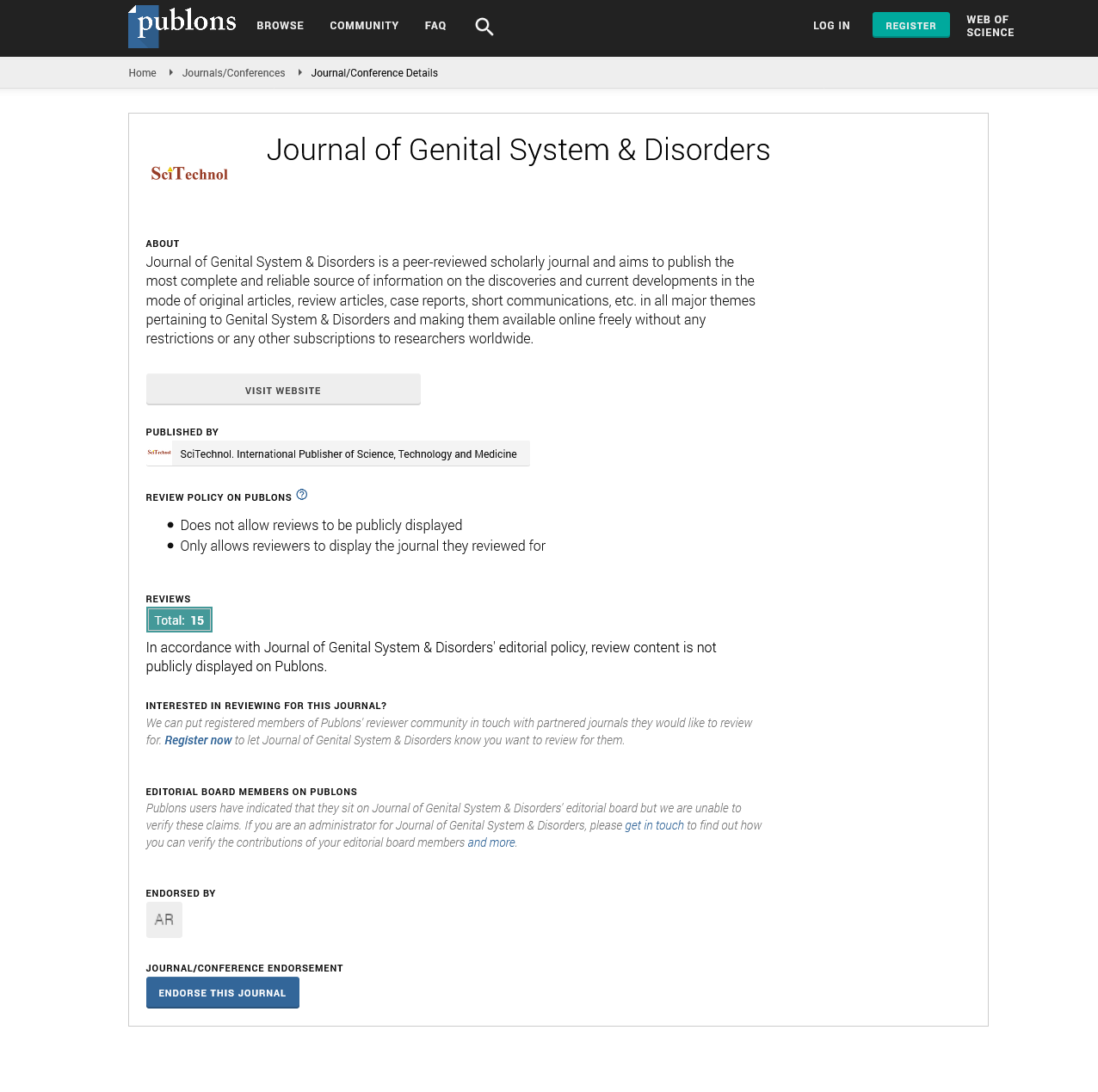Perspective, J Genit Syst Disord Vol: 12 Issue: 2
Polycystic Ovary Syndrome: Pathophysiology, Clinical Manifestations, and Management Strategies
Linda Serati*
1Department of Obstetrics and Gynecology, University of Insubria, Varese, Italy
*Corresponding Author:Linda Serati,
Department of Obstetrics and Gynecology,
University of Insubria, Varese, Italy
E-mail: lindaserati@hotmail.com
Received date: 22 May, 2023, Manuscript No. JGSD-23-107301;
Editor assigned date: 24 May, 2023, PreQC No. JGSD-23-107301 (PQ);
Reviewed date: 08 June, 2023, QC No. JGSD-23-107301;
Revised date: 16 June, 2023, Manuscript No. JGSD-23-107301 (R);
Published date: 26 June, 2023 DOI: 10.4172/2325-9728.1000279
Citation: Serati L (2023) Polycystic Ovary Syndrome: Pathophysiology, Clinical Manifestations, and Management Strategies. J Genit Syst Disord 2023, 12:2.
Description
Polycystic Ovary Syndrome (PCOS) is a multifaceted disorder that affects approximately 5%-15% of women of reproductive age. It is characterized by hyperandrogenism, ovulatory dysfunction, and polycystic ovaries. PCOS is associated with a range of reproductive and metabolic abnormalities, including infertility, irregular menstrual cycles, hirsutism, obesity, insulin resistance, and an increased risk of cardiovascular disease. Understanding the complexities of PCOS is crucial for healthcare professionals to effectively diagnose, treat, and support women with this condition.
Pathophysiology
The exact etiology of PCOS remains complex and multifactorial, involving both genetic and environmental factors. Insulin resistance and hyperinsulinemia play a significant role in the pathogenesis of PCOS, contributing to hyperandrogenism, dysregulated ovarian function, and metabolic disturbances. Excessive insulin levels stimulate ovarian androgen production, disrupt the hypothalamicpituitary- ovarian axis, and inhibit Sex Hormone-Binding Globulin (SHBG) production, leading to increased circulating levels of free testosterone. Additionally, dysregulation of Gonadotropin-Releasing Hormone (GnRH) and Luteinizing Hormone (LH) secretion contributes to anovulation and follicular arrest.
Clinical manifestations and diagnostic criteria
The clinical presentation of PCOS varies among individuals and may include menstrual irregularities (oligomenorrhea or amenorrhea), signs of hyperandrogenism (hirsutism, acne, androgenic alopecia), and polycystic ovaries on ultrasound examination. To facilitate diagnosis, several diagnostic criteria have been established, including those proposed by the Rotterdam Consensus in 2003, which require the presence of at least two out of three criteria: oligo or anovulation, clinical and/or biochemical signs of hyperandrogenism, and polycystic ovaries on ultrasound.
Management strategies
The management of PCOS focuses on addressing individual symptoms and minimizing long-term health risks. Lifestyle modifications, including weight loss, regular physical activity, and a balanced diet, are essential components of PCOS management, particularly in overweight or obese individuals. Oral Contraceptive Pills (OCPs) are often prescribed to regulate menstrual cycles and manage hyperandrogenism. Anti-androgen medications, such as spironolactone, can be effective in treating hirsutism and acne. For women desiring pregnancy, ovulation induction with medications such as clomiphene citrate or letrozole may be recommended. In cases of infertility not responsive to medication, assisted reproductive technologies, such as In vitro Fertilization (IVF), may be considered. Additionally, managing metabolic comorbidities, such as insulin resistance, dyslipidemia, and cardiovascular risk factors, is crucial for long-term health.
Future directions
PCOS remains a complex and heterogeneous condition, requiring ongoing research to improve diagnostic accuracy and individualized treatment approaches. Advancements in molecular genetics, epigenetics, and metabolomics are shedding light on the underlying mechanisms and potential biomarkers of PCOS. Additionally, understanding the interplay between environmental factors, gut microbiota, and PCOS development may provide novel therapeutic targets. Collaborative efforts between researchers, healthcare providers, and patients are vital in advancing our understanding and management of PCOS.
Conclusion
Polycystic ovary syndrome is a common endocrine disorder with diverse manifestations that extend beyond reproductive health. Understanding the pathophysiology, clinical features, and diagnostic criteria of PCOS is essential for accurate diagnosis and appropriate management. The treatment strategies to individual patient needs, considering reproductive goals, metabolic health, and overall wellbeing, is crucial for optimizing outcomes. Ongoing research and multidisciplinary collaborations will continue to enhance our understanding of PCOS and facilitate improved care for women affected by this condition.
 Spanish
Spanish  Chinese
Chinese  Russian
Russian  German
German  French
French  Japanese
Japanese  Portuguese
Portuguese  Hindi
Hindi 
